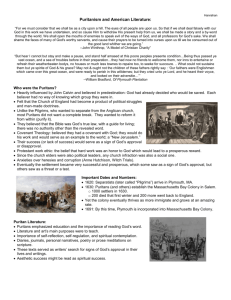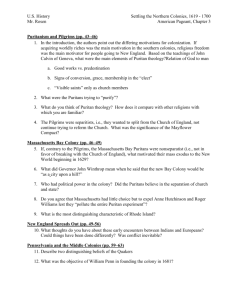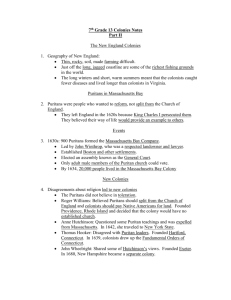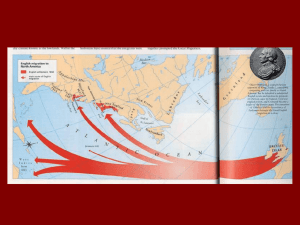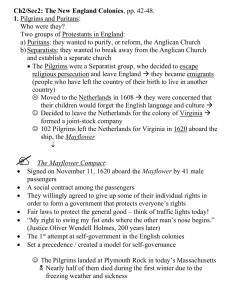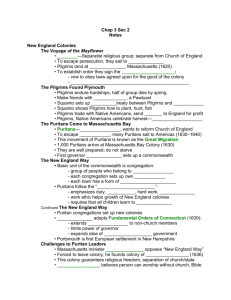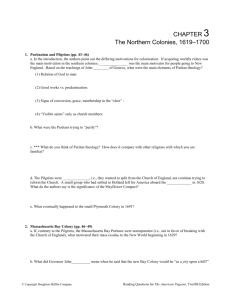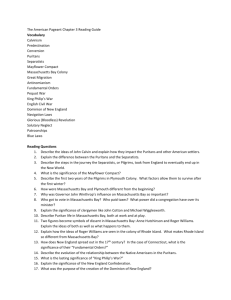Settling the Northern Colonies 1619-1700
advertisement
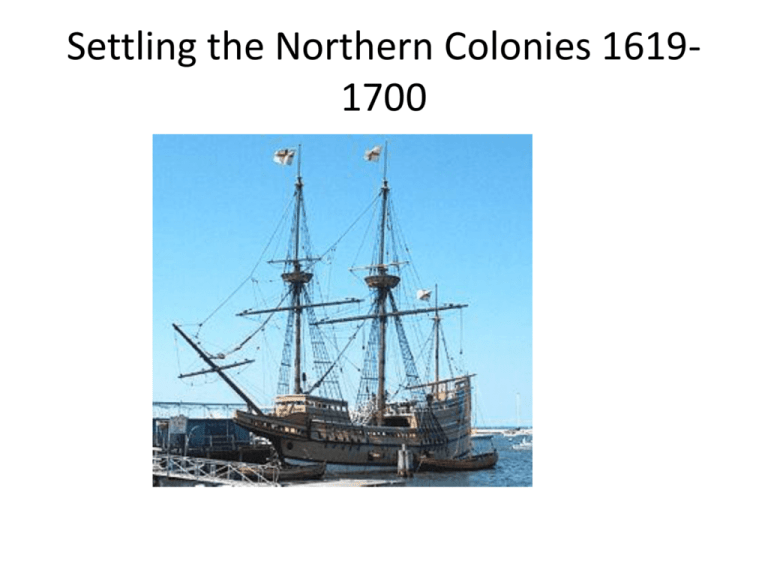
Settling the Northern Colonies 16191700 The Protestant Reformation Produces Puritanism • • • • • Martin Luther starts the Reformation. John Calvin expands upon Luther’s ideas afterwards. Published Institutes of the Religion in 1536. To Calvin, humans were weak and sinful. Only the predestined could go to Heaven, no matter what. A reaction to the Roman Catholic Church’s combination of indulgences and good works . Puritans believed in Calvin’s story. Divided into two groups: Larger group worked within Anglican Church for reform. Smaller group left the church and became known as Separatists. Under James I, Separatist Puritans went into exile to escape religious persecution. Most fled to Holland, another Protestant nation. Dutch were also heavily into the wool trade as were many Puritans. England becomes Protestant • • • • • Henry VIII broke ties with the Catholic Church in the 1530’s over a dynastic question. He divorced his first wife, Catherine of Aragon, the daughter of Charles V of Spain and Austria and the Holy Roman Emperor. Some became “Puritans” who wanted to purify the English church of its Roman Catholic influences. James VI of Scotland became King James I of England in 1603 and maintained the Anglican Church the faith of England. He banished many of these so-called Puritans because they questioned his authority as head of the English or Anglican Church. Separatist Puritans became Pilgrims The Pilgrims End Their Pilgrimage at Plymouth • • • • • The Pilgrims or Separatists came from Holland after having fled the wrath of James I. The Pilgrims (only half of whom were Separatists) The Pilgrims spoke with the Virginia Company and resolved to settle far to the north of Jamestown. They had no charter, they were going to settle illegally. They were “squatters”. The Pilgrims actually made a few surveys before landing at Plymouth. Before they left the ship they signed the Mayflower Compact, a set of rules all agreed to obey. Miles Standish was a skilled soldier and negotiator. The Pilgrims (Continued) • 102 people land at Plymouth. The winter was very tough. Only 44 of the 102 original Pilgrims survived. • Thanks to the advice of Squanto, a local Wampanoag indian, harvests were bountiful and the first Thanksgiving was celebrated. • William Bradford was chosen as governor of Plymouth thirty times. Plymouth exported dry fish, furs and lumber. • In 1691, Plymouth merged with the larger Massachusetts Bay Colony. The Bay Colony Bible Commonwealth • In 1629, non-Separatist Puritans obtained a royal charter to settle in the New World. They secretly kept the charter later using it as the basis for their constitution. • Well equipped group: 11 ships and 1000 colonists • John Winthrop was elected governor for 19 years, Mass Bay prospered in fur, timber and fisheries trades. Building the Bay Colony • The right to vote was soon extended to all “freemen” adult males who belonged to Puritan congregations. • Winthrop feared democracy; religious leaders wielded considerable power. • John Cotton was a prominent minister who emigrated to Massachusetts to escape persecution for his criticism of the Anglican Church. • Earthly pleasures were not prohibited but regulated; public signs of affection (ie. kissing) could draw a fine even if couple was married. Troubles in the Bible Commonwealth • Ironically, even as they had rebelled against orthodoxy, the Puritans sought to enforce it. • Quakers were flogged, fined and banished. • Anne Hutchinson defied Church elders with her claim that predestination made all good works completely irrelevant. “Antinomianism” • The Rhode Island "Sewer" • Roger Williams fled to the Rhode Island area in 1636. There, he established religious freedom for all kinds of people. New England Spreads Out • New England Spreads Out • Hartford and Connecticut were founded in 1635. An energetic group of Boston Puritans poured into the Hartford area lead by Reverend Thomas Hooker. (Colony) • In 1639, the settlers of the new Connecticut River colony drafted a document known as the Fundamental Orders. It was basically a constitution. • New Haven was established in 1638. • Part of Maine was purchased by Massachusetts Bay in 1677 from the Sir Ferdinando Gorges heirs. • In 1641, New Hampshire was absorbed by the greedy Massachusetts Bay. The king took it back and made New Hampshire a royal colony in 1679. New England Spreads Out Puritans Versus Indians • • • • Puritans versus Indians The Wampanoag chieftain, Massasoit, signed a treaty with the Plymouth Pilgrims in 1621. The Wampanoag helped the Pilgrims have the first Thanksgiving in that same year. In 1637, hostilities exploded between the English settlers and the powerful Pequot tribe. The English militiamen and their Narragansett Indian allies annihilated the Pequot tribe. In 1675, Massasoit's son, Metacom (also nicknamed King Philip by the English) launched a series of attacks and raids against the colonists' towns. The war ended in 1676. Seeds of Colonial Independence • • • • • • Seeds of Colonial Unity and Independence In 1643, 4 colonies banded together to form the New England Confederation. It was made to defend against foes or potential foes. The confederation consisted of only Puritan colonies - two Massachusetts colonies (the Bay Colony and small Plymouth) and two Connecticut colonies (New Haven and the scattered valley settlements). Each colony had 2 votes, regardless of size. As a slap at the Massachusetts Bay Colony, King Charles II gave rival Connecticut in 1662 a sea-to-sea charter grant, which legalized the squatter settlements. In 1663, the outcasts in Rhode Island received a new charter, which gave kingly sanction to the most religiously tolerant government yet devised in America. In 1684, the Massachusetts Bay Colony's charter was revoked by London authorities. Andros promotes the first American Revolution • • • • • • • Andros Promotes the First American Revolution In 1686, the Dominion of New England was created by royal authority. Unlike the homegrown New England Confederation, it was imposed from London. It embraced all of New England until in 1688 when it was expanded to New York and East and West Jersey. The leader of the Dominion of New England was Sir Edmund Andros - an able English military man. He established headquarters in Puritanical Boston. Andros stopped the town meetings; laid heavy restrictions on the courts, the press, and schools; and revoked all land titles. In 1688-1689, the people of old England engineered the Glorious (or Bloodless) Revolution. They dethroned Catholic James II and enthroned the Protestant rulers of the Netherlands, the Dutchborn William III and his English wife, Mary, daughter of James II. In 1691, Massachusetts was made a royal colony. There was unrest in New York and Maryland from 1689-1691, until newly appointed royal governors restored a semblance of order. Old Dutch at New Netherland • • • • • • • • Late in the 16th Century, the Netherlands fought for and won its independence from Catholic Spain with the help of England. In the 17th Century, the Dutch (the Netherlands) became a power. Golden Age. It fought 3 great Anglo-Dutch naval battles. The Dutch Republic became a leading colonial power, with by far its greatest activity in the East Indies. The Dutch East India Company was nearly a state within a state and at one time supported an army of 10,000 men and a fleet of 190 ships, 40 of them men-of-war. This company hired an English explorer, Henry Hudson, to seek great riches. He sailed into the Delaware Bay and New York Bay in 1609 and then ascended the Hudson River. He filed a Dutch claim to a wooded and watered area. The Dutch West India Company was less powerful than the Dutch East India Company, and was based in the Caribbean. It was more interested in raiding than trading. In 1628, in raided a fleet of Spanish treasure ships and stole $15 million. The company established outposts in Africa and Brazil. In 1623-1624, the Dutch West India Company established New Netherland in the Hudson River area. It was made for its quick-profit fur trade. The company also purchased Manhattan Island from the Indians for worthless trinkets. The island encompassed 22,000 acres. New Amsterdam, later New York City, was a company town. The Quakers were savagely abused. Dutch Friction with English and Swedish Neighbors • • • • New England was hostile to the growth of its Dutch neighbor, and the people of Connecticut finally ejected intruding Hollanders from their verdant valley. 3 of the 4 member colonies of the New England Confederation were eager to wipe out New Netherland with military force. Massachusetts, providing most of the troops, rejected this. From 1638-1655, the Swedish trespassed on Dutch preserves by planting the anemic colony of New Sweden on the Delaware River. The Golden Age for Sweden was during and following the Thirty Years' War of 1618-1648, in which its brilliant King Gustavus Adolphus had carried the torch for Protestantism. Resenting the Swedish intrusion, the Dutch dispatched a small military expedition in 1655. It was led by the able of the directors-general, Peter Stuyvesant, who had lost a leg while soldiering in the West Indies and was dubbed "Father Wooden Leg" by the Indians. The main fort fell after a bloodless siege, whereupon Swedish rule came to an abrupt end. Dutch Residues in New York • • • In 1664, Charles II granted the area of modern-day New York to his brother, the Duke of York, and that year, British troops landed and defeated the Dutch, kicking them out, without much violence. New Amsterdam was renamed New York. The Dutch Legacy – The people of New York retained their autocratic spirit. – Dutch names of cities remained, like Harlem, Brooklyn, and Hell Gate. Even their architecture left its mark on buildings. – The Dutch also gave us Easter eggs, Santa Claus, waffles, sauerkraut, bowling, sleighing, skating, and golf. Penn’s Holy Experiment in Pennsylvania • • • • • The Quakers (characteristics) They “quaked” under deep religious emotion. They were offensive to religious and civil rule. They addressed everyone with simple “thee”s and “thou”s and didn’t swear oaths because Jesus had said “Swear not at all,” this last part creating a problem, since you had to swear a test oath to prove that you weren’t Roman Catholic. Though stubborn and unreasonable, they were simple, devoted, democratic people against war and violence. Penn’s Holy Experiment in Pennsylvania • • • • • • • • • • William Penn, a well-born Englishman, embraced the Quaker faith. In 1681, he managed to secure an immense grant of fertile land from the king. It was called Pennsylvania, in honor of Penn, who, being the modest person that he was, had insisted that it be called Sylvania. It was the best advertised of all the colonies. XV. Quaker Pennsylvania and Its Neighbors Thousands of squatters already lived in Pennsylvania. Philadelphia was more carefully planned than most cities, with beautiful, wide streets. Penn bought land from the Indians, like Chief Tammany, later patron saint of New York’s political Tammany Hall. His treatment of the Indians was so gentle that Quakers could walk through Indian territory unarmed without fear of being hurt. However, as more and more non-Quakers came to Pennsylvania, they mistreated the Indians more and more. Pennsylvania • By 1700, only Virginia was more populous and richer. • Penn, unfortunately, was not well-liked because of his friendliness towards James II, the deposed Catholic king, and he was jailed at times, and also suffered a paralytic stroke, dying full of sorrows. Pennsylvania • New York, New Jersey, Delaware, and Pennsylvania – All had fertile soil and broad expanse of land. – All except for Delaware exported lots of grain. – The Susquehanna River tapped the fur trade of the interior, and the rivers were gentle, with little cascading waterfalls. – The middle colonies were the middle way between New England and the southern plantation states. – Landholdings were generally intermediate in size. – The middle colonies were more ethnically mixed than other colonies. – A considerable amount of economic and social democracy prevailed. – Benjamin Franklin, born in Boston, entered Philadelphia as a seventeen-year-old in 1720 with a loaf of bread under each arm and immediately found a congenial home in the urbane, open atmosphere of the city. Pennsylvania • • • • • • • • • In the 1600s, England was undergoing a massive population boom. About 75% of English immigrants were indentured servants. Most of them were young men from the “middling classes.” Some had fled during the cloth trade slump in the early 1600s while others had been forced off their land due to enclosure. Some 40% of indentured servants died before their seven years were over. Late in the 17th century, as the supply of indentured servants slowly ran out, the southerners resolved to employ black slaves. From 1629 to 1642, 11,000 Puritans swarmed to the Massachusetts Bay Colony. In contrast to the indentured servants, Puritans migrated in family groups, not alone. Puritans brought the way of life from England with them to America.
